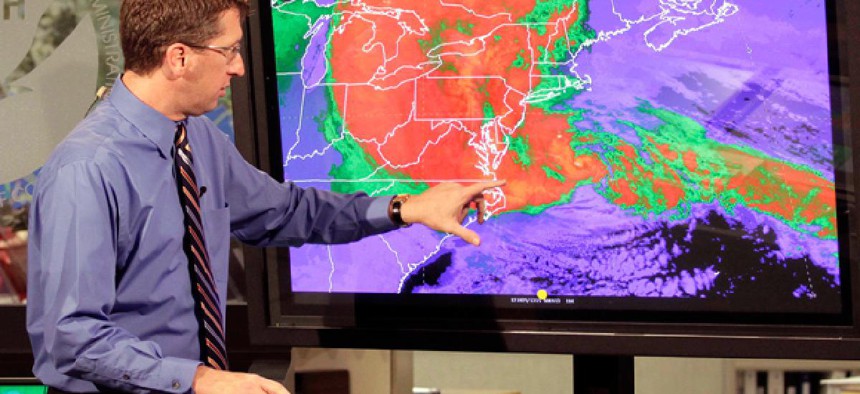Sandy unfolding as forecast, says National Hurricane Center chief
FEMA head says storm will have an impact on federal elections.
The storm-system combination called Sandy is “on track as generally forecast” to make landfall on the Mid-Atlantic coast Monday night even though it has temporarily accelerated, according to National Hurricane Center Director Rick Knabb.
In a Monday afternoon conference call with reporters, Knabb said “it is difficult to tell in a situation in which the storm system is tilted and beginning to lose its tropical characteristics,” but all aircraft and satellite data point to the storm slowing down by Tuesday, he said.
Federal Emergency Management Agency administrator Craig Fugate on the same call said the $3.6 billion federal disaster relief fund should be sufficient to cover this week’s response to Sandy, though more funds might be needed during the post-impact recovery phase.
“The hurricane will have impact on the federal elections,” he said, recalling his experience running Florida’s emergency response just before the 2004 elections when polling station equipment was damaged and states had to be reimbursed for expenses. He said his agency’s chief counsel is working on proper guidance on how to support jurisdictions that may be declared disaster areas, working with state election commissions, governors, Cabinet members or secretaries of state on election infrastructure. “But it’s too early to say whether Election Day will be affected,” he said.
Since Sandy made its presence known, FEMA has been “rapidly preparing to support response operations with bottled water, meals, blankets, and cots as well supplies from our partners such as the Red Cross and private-sector firms, Fugate said. In the Northeast, the partners have already delivered 600,000 litres of water 490,000 meals to evacuees, working through FEMA’s newly stood-up National Business Enterprise Outreach Center.
FEMA is also working with states on generator needs, having shipped 400 of them already, some large enough to power hospitals and water treatment centers, he said. FEMA is exploring leasing more through the U.S. Army Corps of Engineers in case of widespread power outages. But delivery, as with power restoration operations, depends on weather conditions “and will slow down as the storm impacts areas, which will have an impact on our ability to respond.”
Knabb said the huge storm and its circulation center will “continue to bring strong winds, heavy rains and elevated water levels to coastal areas.” The best course for staying safe, he said, was to heed local watch and warn alerts. “It will be a long-duration event, so expect wind glides, tropical and gale-force winds.”
He expects water levels four-to-eight feet above ground level from the DelMarVa peninsula north to Connecticut, though Massachusetts and Long Island also are affected, the latter reaching water levels of 6 to 11 feet. Rainfall could be 6 to 8 inches, but more than a foot in some localities, which could lead to flash flooding. The snowstorms in West Virginia,officials said, make for an “unprecedented combination.”
Despite some changes in the timing of the storm’s peak surge, he said, “we can’t let our guard down by thinking that a few hours difference will change the overall outcome. We must stay stay the course on what we think the peak values will be.” Both Fugate and Knabb recommended that people listen to their local National Weather Service instructions, which vary.
Hurricane Sandy is “unique in a number of ways,” Knabb said, noting that the full moon may have added a foot or two to tide heights. “It is not common for a storm to come at this strength in this direction toward the New Jersey coast and not common to have a system of this magnitude coming in this direction at this time of year. But tropical cyclones have come up the East Coast in the past,” he added, citing Isabel in 2003 and Irene last year. “The coast is vulnerable.”
Anticipating the aftermath of Sandy, Fugate said assistance for housing will be key, based on needs and the extent of flooded homes. As a safety warning, he noted that “in the aftermath we oftentimes see people who after the storm lose their lives in accidents. Just because storms have passed does not mean it’s safe.”




